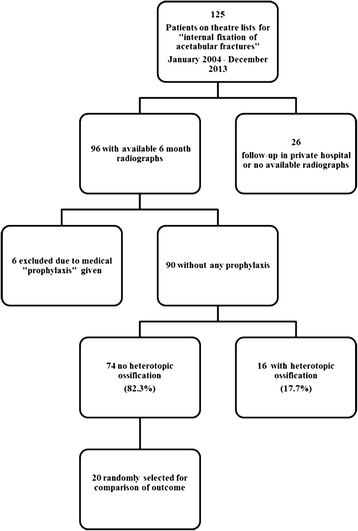Incidence and clinical relevance of heterotopic ossification after internal fixation of acetabular fractures: retrospective cohort and case control study
- PMID: 25956896
- PMCID: PMC4429472
- DOI: 10.1186/s13018-015-0202-z
Incidence and clinical relevance of heterotopic ossification after internal fixation of acetabular fractures: retrospective cohort and case control study
Abstract
Objective: The aim of the study was to evaluate predictors and clinical relevance of heterotopic ossification (HO) in patients treated for acetabular fractures in a tertiary referral centre.
Patients and methods: The study is a retrospective cohort study with a nested case-control study. All patients treated with internal fixation of acetabular fractures from January 2004 to October 2013. Ninety patients had postoperative imaging available at 6 and 12 months postoperatively and received no prophylaxis. Plain radiographs were used to grade HO. The Hip disability and Osteoarthritis Outcome Score (HOOS) was used to compare outcomes between patients suffering from HO with patients who did not.
Results: Sixteen patients (17.7%) suffered from HO. According to the Brooker classification, 5 had class I, 4 class II, 3 class III and 4 class IV HO. Traumatic brain injury (TBI) was the only significant risk factor for developing HO (odds ratio (OR) 8.6, 95% confidence interval (CI) (1.693-43.753), p = 0.014). The HO rate in patients with an anterior (ilioinguinal) or posterior (Kocher-Langenbeck) surgical approach was 20% and 21% respectively, and the HO rate in patients with a combined approach was much lower at 11%. Neither fracture type nor gender nor age increased the risk of HO significantly. The outcome measured by HOOS was not significantly different between patients with HO and patients in the control group. Patients with HO Brooker class II-IV had slightly lower (effect estimate +4.25, 95% CI (-10.2 to +12.10), p = 0.220) HOOS compared to the majority of the control group.
Conclusion: A very low rate of HO was found compared to the HO rates described in other studies with similar patient cohorts who received prophylaxis. Based on our findings and the current literature, we do not recommend giving prophylaxis against HO to patients after internal fixation of acetabular fractures.
Figures



References
-
- Brooker AF, Bowerman JW, Robinson RA, Riley LH., Jr Ectopic ossification following total hip replacement. Incidence and a method of classification. J Bone Joint Surg Am. 1973;55(8):1629–1632. - PubMed
MeSH terms
LinkOut - more resources
Full Text Sources
Other Literature Sources
Medical

